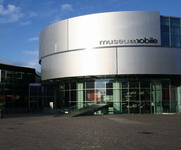The three-wheeled "Patent motor car" developed by Karl Benz in Mannheim and the four-wheeled "Daimler motor car" produced by Gottlieb Daimler in Cannstatt were the world's first petrol-engined vehicles. Unlike the steam-driven or electrically-powered cars created by various inventors across Europe, some dating back as far as the 17th century, these petrol-engined cars proved a great success. Produced in 1886, they marked the birth of the modern-day car.
Despite lacking the comfort of the horse-drawn carriage and the by then well-established railway, the car was an absolute triumph. At first, it was only used for outings by the aristocracy - even the Kaiser himself became a car fanatic - and the upper echelons of society, but by the beginning of the 20th century it was also being used for racing. This fascination with speed led to the development of new models such as the 'Blitzen Benz', which reached the magic mark of 200 kilometres per hour (124.2 mph) in 1909.
After the First World War, the car industry became an important part of the economy. There were only around 60,000 passenger cars registered in Germany in 1921, but just two years later this number had risen to more than 100,000. During this time, an important milestone was set by Opel in Rüsselsheim: the first production car, nicknamed the "tree-frog" because of its green colour, rolled off the assembly line. As a result of the world economic crisis in 1929, many manufacturers went bankrupt while others were forced to forge alliances. In 1932, Audi, DKW, Horch and Wanderer merged to form the Auto Union, the forerunner of today's Audi AG - represented from that time by the logo of the four interlinked rings.






